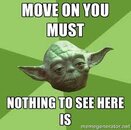How can this signal be effective if so many are practicing this habit of MOF in a non distress manner?
This distress sign has shown to be confusing and not reliable and it should be substituted by another sign/signal.
This is possibly one of the silliest posts I've read on the MOF topic... and that says a lot.
To repeat for the eleventy-thousandth time:
A mask on a diver's forehead IS NOT A SIGNAL.
The words SIGNAL and SIGN mean two different things. They are not interchangeable.
Panicked divers whose masks end up on their forehead DO NOT put them there as some specifically conscious "signal" of distress.
NO ONE teaches that panicked divers should somehow remember to place their masks on the forehead in order to alert others that they are in distress.
NO ONE says to themselves "OK, I'm in distress... what do I do first? Oh yeah... I need to put my mask on my forehead in order to signal to others that I'm in distress!"
A mask on diver's forehead IS NOT a universal or absolute sign of distress. It is neither necessary nor sufficient to make that determination.
HOWEVER...
Rejecting gear - spitting the reg, ripping the mask off, and YES even shoving it up off the face and onto the forehead - is often an unconscious, involuntary, reflexive reaction to distress. Accordingly, in conjunction with other indicators, a mask on a diver's forehead may be one possible sign of distress.
Suggesting that MOF is "flawed" and should be replaced as a sign of distress is like suggesting that someone who is choking on food in a restaurant should find a better way to communicate that fact than jumping up out of their chair and frantically clutching their throat while making ridiculous facial expressions.




